Film Review: The Conjuring (Hallowe’en Post # 1)
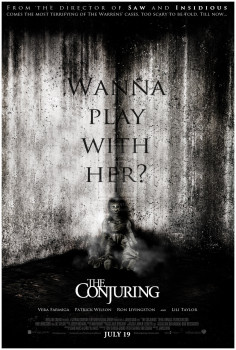 “Before there was Amityville, there was Harrisville.”
“Before there was Amityville, there was Harrisville.”
Whatever you think of the Warrens as real people, they do make mighty fine fictional characters.
Ed and Lorraine Warren — dark-forces-battling demonologists associated with such notoriously famous cases as the Amityville Horror — provide us with supernatural sleuths who fit comfortably in the tradition of such occult detectives as Doctor Abraham Van Helsing, Carnacki the Ghost Finder, and John Thunstone. That the Warrens are real people and the cases they have investigated are allegedly true does add another compelling dimension to the whole enterprise.
But I’m not here to debate whether the Warrens’ adventures were bona fide excursions into paranormal realms or just elaborately staged (and profitable) hoaxes. I’m here to review The Conjuring — the 2013 horror film purportedly based on the Warrens’ 1971 investigation into the Perron family’s troubled Rhode Island farmhouse. I am meeting it on its own terms, not as a docudrama, but as a fright flick.
Still, I’ll make a few observations about the “based on a true story” conceit, which is wrung for full effect in opening and closing montages. Judging from interviews, the scriptwriters — twin brothers Chad and Carey W. Hayes — certainly give the impression that they buy in to the Warrens’ whole shtick, or are at least pretty open-minded to it. However, that clearly did not constrain them only to crafting a straight-ahead historical re-enactment. To the contrary, their prime focus is to use the original case as a springboard for launching wall-to-wall scares at an audience hungry for terror of the supernatural kind. They start out eerie, sprinkling in events that may well be straight out of the case file, and then liberally follow those up with any tried-and-true horror effect that will “get” the audience. It is a film full of “gotchas.”
Whether director James Wan, best known for the first Saw film (2004) and his previous hugely successful haunted-house thriller Insidious (2010), is a skeptic or a believer I do not know, and it almost seems beside the point. He is adept at working with this material, at wringing out the horror and suspense. He is good at staging these stories, and as any teller of ghost stories knows, being able to precede such a tale with “This really happened to ____ in the year ____ at _____” amps it up tenfold. Grounding the events in some plausibility makes the scares all that more effective. It provides a peg to hang your suspension-of-disbelief hat on, at least for the duration of the film, even if you again leave the theater a skeptic.
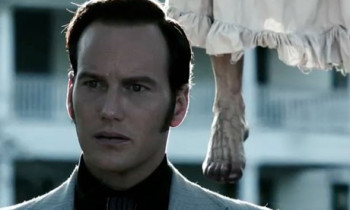 Even those who fervently swear that the original case was real — such as one of the Perron’s five daughters, now in her fifties, who was an advisor to the filmmakers — must concede that the final act is pure fabulation. No possessed, scissor-wielding mother terrorized anybody in the original case — not until the story was fed through the Hollywood sensationalization machine. And I’m sure there were many liberties taken throughout the film. Nonetheless, having all those trappings of an allegedly true case does help to prep us as the tension builds from eerie to horrifying.
Even those who fervently swear that the original case was real — such as one of the Perron’s five daughters, now in her fifties, who was an advisor to the filmmakers — must concede that the final act is pure fabulation. No possessed, scissor-wielding mother terrorized anybody in the original case — not until the story was fed through the Hollywood sensationalization machine. And I’m sure there were many liberties taken throughout the film. Nonetheless, having all those trappings of an allegedly true case does help to prep us as the tension builds from eerie to horrifying.
As a haunted-house horror film, it is quite effective, and critics largely agreed (certified 86% fresh on rottentomatoes.com’s critic aggregator the “Tomatometer”). I was amused, though, to note how several critics complained that while the material was well done, it didn’t do much new. “We’ve seen this all before” was a recurring note — either in praise of the film being “retro” or as a criticism of its being a rip-off — followed by citations of Poltergeist (1982), The Exorcist (1973), and one or two more recent films like Paranormal Activity (2007).
Here’s the thing: this is a genre I know well, a genre I love and am so often disappointed by because there are so few good haunted-house films. I can count off the classics of the sub-genre on one hand, whereas to do so with virtually any other category would take at least both of my hands and possibly my feet. The reason the same four or five films are always cited as the ones Wan either paid homage to or stole from is because those are about the only ones worth mentioning (although none of the critics I read cast a nod back to the masterpiece of the genre: Robert Wise’s 1963 The Haunting). It is a small subset of a genre to begin with, and so few really good ones that when you come across anything decent it is like finding a minor gem after digging through mounds of dreck — you rejoice and revel in the chills and frights you were hoping for, from a film that does not leave you feeling like, yet again, you kinda misspent two hours of your life on something that could only be redeemed by watching it with two wisecracking robots.
The techniques Wan used in his previous haunted-house flick Insidious work even better here, demonstrating that when it comes to scaring an audience, few in Hollywood today are as deft at the art of the scare. The long tracking shot that establishes the family moving into the house is brilliant, and his camera beautifully captures how old this house is; we can feel the history oozing from its walls. Slow builds, lingering shots, and the impact that can be garnered simply from sounds: he handles all of these tools with finesse — he is at the top of this game, which is why, as one reviewer noted, the trailers for a Wan film are scarier than most horror films.
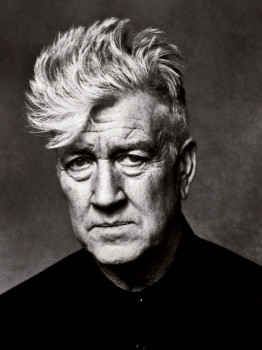
(I’m compelled to note here that the filmmaker who, in my opinion, is the undisputed master of ratcheting up this kind of dread is a director whose films are not generally classified as horror. That would be David Lynch. Give Lynch an empty hallway, a camera, and a soundtrack, and he’ll put in the can two minutes of footage that will have you in a cold sweat. He will take you down that hall, accompanied by strange, unsettling non-diegetic sounds barely audible on the soundtrack, so aware of the space, of every angle and shadow — and what is at the end of that hall? do you want to go there do you really want to go there? you have no choice the camera’s not turning back it is slowly pushing you forward it is relentless — . That man can unnerve you, my friend. Why more horror filmmakers don’t take a page from Lynchland, I’ll never know, but Wan sometimes manages to come closer than most).
Although some of the third-act frights might be a bit over the top, they never do devolve into the excesses of some notorious CGI-laden crapfests of recent years like the 1999 remake of The Haunting or many of the Dark Castle Entertainment endeavors (House on Haunted Hill [1999], Thirteen Ghosts [2001]). You know, gee whiz what a surprise — sometimes it’s more scary if it looks like it’s really happening and not like it’s a video game! Plus it frees up some of your budget to get better actors.
Many of the most effective scares in this film are achieved by using the ambience and creepy atmosphere of the house itself, along with a deliberate balance of sound and silence: a great example is the tour-de-force scene in which Mrs. Perron (Lili Taylor) thinks she is playing a game of Blind Man with her youngest daughter in the empty house. The blindfolded seeker can ask the hider to clap three times. The claps lead her to a spooky old wardrobe, and on the third clap we see the ghostly hands. The mother is duly shocked to discover that the wardrobe was empty and that her daughter was hiding in a different part of the house.
That scene was played nearly in its entirety in an early trailer for the film, and that preview had the audience, who had barely settled into their seats, riveted. At the pay-off, many yelped and jumped, followed by the expected tittering and chattering that follows an effective scare — that cathartic release of “Wow, that scared me but it’s only make believe! I’m here in a movie theater with my bucket of popcorn, safe and sound unless a psychopath comes in with a gun or the guy coughing next to me has Ebola.”
The writers have noted that their big breakthrough with the material came when they took the original script treatment and shifted the POV from the haunted family to the investigators. This does strike me as a canny move. As a longtime connoisseur of such films, I can tell you that most of them do focus on the hapless haunted victims as the main POV characters (think Poltergeist as a prime example). Those are the characters with whom we most empathize, perhaps, but the investigators, the people who come into your house, set up all their equipment, and try to capture evidence of the otherworldly are really odd, unusual, and intriguing characters. By focusing so much on the Warrens’ point of view, it humanizes and adds dimensionality to them, and they turn out to have some fascinating, strange, and quirky ideas, even if you tend to disagree with some of their more orthodox Catholic views (at one point, Ed [Patrick Wilson] places crucifixes throughout the Perrons’ house, explaining that the dark spirits don’t like religious icons and that this will rile them up and get their attention. “Sort of like vampires?” Mr. Perron asks. “Yes,” Ed replies, “except that I don’t believe in vampires.”)
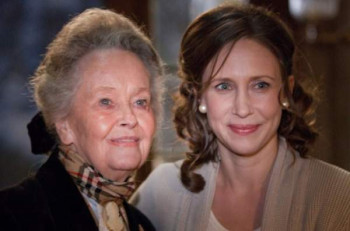 Lorraine (Vera Farmiga, in a nuanced, well-played role that is both smart and sexy, strong and vulnerable) especially becomes the intriguing central hero of the film, revealing a great gift that is both a heavy burden and a responsibility — she believes she has been given her second sight in order to fight the forces of evil alongside her husband, and it is she who unravels the mystery of what is haunting the house and who most intimately confronts it. In flashbacks, the sacrifices she makes is revealed with reference to visions she has had that are too horrible even to share with her husband.
Lorraine (Vera Farmiga, in a nuanced, well-played role that is both smart and sexy, strong and vulnerable) especially becomes the intriguing central hero of the film, revealing a great gift that is both a heavy burden and a responsibility — she believes she has been given her second sight in order to fight the forces of evil alongside her husband, and it is she who unravels the mystery of what is haunting the house and who most intimately confronts it. In flashbacks, the sacrifices she makes is revealed with reference to visions she has had that are too horrible even to share with her husband.
Her power of seeing the spirit world is revealed in another deftly realized scene when the Warrens first enter the Perrons’ home. While the usual greetings and introductions are made, we can’t help but notice the slightly pained look on Lorraine’s face as she is introduced to the various family members — not overplayed, just enough that perhaps it could be dismissed as her having had a lunch that was not settling well. Shortly thereafter, moments of the scene are replayed in quick-edit cuts that show what she was seeing as she was introduced to the family — various ghosts and, most disturbingly, a dark entity lurking near them and “feeding” off them. Even when Ed wants to throw in the towel out of concern for the safety of their daughter and for his wife’s emotional well being, Lorraine insists on seeing it through, fervently believing that God brought them together for this purpose to help people as warriors against the forces of darkness.
We do get some POV from the family, of course — but that is almost wholly limited to the actual paranormal events, very little in terms of subplots for fleshing out individual family members. This is really a movie about the Warrens, at least the fictionalized version of them. What the studio has perhaps inadvertently created in making that move is a franchise duo that could support a number of films. Could Ed and Lorraine Warren action figures be far behind? Complete with toy ghost-hunting equipment and crucifixes, just the right scale for playing out an exorcism of Barbie doll?
There is another bone of contention that a few critics picked: the strict Catholic orthodoxy that the movie hews to with regard to demons, even going so far as to suggest that (at least some of) the Salem witches were, indeed, practicing witches who worshipped Satan and sacrificed babies. Not cool, but also not an unfamiliar trope in horror fiction. Taking some of those lurid stories of evil witches performing their unholy Sabbaths in the woods and using those stories as a “What if?” premise has provided useful fodder for horror writers, but what makes it a little more shaky here is the fact that the film is being touted as “based on a true story.” It’s a film that should probably be boycotted by wiccans.
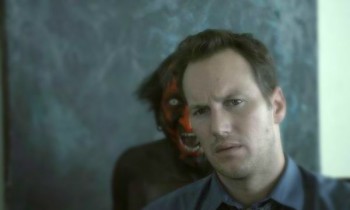
Allegedly the footage that the Warrens’ ghost-hunting crew got of the paranormal manifestations was so shocking and convincing that the Vatican fast-tracked approval of a priestly house-cleaning for a non-Catholic, unbaptized family — something almost unheard of. Boy, I’d like to see that original footage, wouldn’t you? I mean, it seems to me that it would either be some pretty compelling evidence for the existence of the paranormal or else it would be an example of a hoax of the first order. If it’s the latter, I can understand why the Warrens never would’ve released it; if it’s the former, I don’t know why they never did. Apparently, according to what I’ve read about the film online, not long after the case Ed recognized the cinematic possibilities, hooked up with a producer, and began trying to get it adapted into a movie. Certainly you would think he would’ve seen the value in the original footage (then again, that was long before Ghost Hunters, Ghost Adventures, and innumerable other paranormal-based reality-TV shows made such footage a cottage industry). But we’re led to understand that all of that footage is still locked away in the Warrens’ archives. Well, again, that’s all beside the point. Ed’s aspirations for the case being turned into a film were realized, and his instincts were correct: the tale does provide a good haunted-house fright flick. Well acted, well staged, it delivers on all fronts. If you’re sitting down to watch this kind of movie, this is one of the better ones out there.
When The Conjuring became one of the most profitable horror flicks of all time last year, New Line Cinema recognized they had a potential franchise on their hands. You have built-in recurring heroes, the Warrens, who have literally hundreds of case files that could be adapted into sequels. So The Conjuring 2: The Enfield Poltergeist is slated for 2016, with Wilson and Farmiga reprising their roles as the demon-hunting husband-and-wife duo. We’ll see if lightning can be conjured twice.
[Ed Warren died in 2006, but Elaine, who at the age of 86 consulted on this film and still consults other paranormal teams and so pops up quite frequently on reality television, makes a cameo. She can be clearly spotted near the front row as the camera zooms over an audience watching a presentation by the film-version Warrens in a college lecture hall.]
In these final days counting down to Hallowe’en, folks are going to be looking for exactly this kind of film. And so I recommend The Haunting (the 1963 version! Don’t accidentally rent the 1999 stinker unless you and your friends are planning a movie-mocking party with alcohol and/or other recreational drugs that might now be legal if you’re reading this in Colorado or Washington). But if you insist on something in color, I say you must see The Changeling (1980). But if you want something faster paced, more FX-laden and in-your-face, there’s really no reason not to revisit Poltergeist (1982). But if you want something more contemporary (or something you haven’t already seen five times), I’d say The Conjuring is a pretty good choice.
The Conjuring (2013)
OZ RATING: 3.5 out of 5 stars
Great post Oz! Look forward to seeing these as the days progress toward Halloween!
I’m a big fan of The Conjuring as well, and like you, I think it’s hard to find a good scary flick anymore that doesn’t rely upon shock/gore or CGI. I also agree with your assessment of the original The Haunting. I’m shocked when I learn that many people have not seen this.
One horror director who takes his time in building tension (though, for me, his movies always seem to miss a beat somehow) is Ti West. I think this guy might be on the verge of making a classic scary movie. Until then, we’ll have to continue scrounging around for good horror flicks.
What did you think of Scott Derrickson’s Sinister?
James,
Thanks! I haven’t watched Sinister yet, but I’ll see if I can nudge it up into my pre-Hallowe’en viewing lineup after work one night this week.
I’ve noticed, now that my children are ages 5 and 3, that I’m about four years behind in my Netflix queue. And as for seeing a film in its theatrical release — forget it! I’ve gotten to two films in theaters this year: Godzilla and Guardians of the Galaxy (when you have limited shots, you really try to pick the good ones!). I reviewed both of those films here, given the rare opportunity actually to review a film concurrent with its opening week.
The Conjuring I DVR’d off of HBO last week, and watched it with my wife on our ninth anniversary after the kids were in bed (isn’t that romantic?).
“The Conjuring I DVR’d off of HBO last week, and watched it with my wife on our ninth anniversary after the kids were in bed (isn’t that romantic?).”
I’ve been married 20 years this past June, and we still have to fight (i.e. be purposeful in planning) for romantic time together. I’ve heard it gets a little easier as kids get older, but not much.
I really recommend Sinister. You might not like it overall–the ending is a bit “meh”. But it has some really creepy scenes, especially some film footage that Ethan Hawke’s character stumbles upon.
Definitely see Sinister. One of the best horror films of 2012. It really packed a wallop.
Okay, with recommendations from James and John, Sinister might be the film my wife and I watch after the kiddos are put to bed and are sleeping off their sugar overloads tomorrow night…
(No movie-watching tonight, alas, because after I get home from a late night guiding a ghost tour, I have to go back in tomorrow morning to teach a Young Writers class on creating believable monsters in stories. It’s a busy time of year for me…)